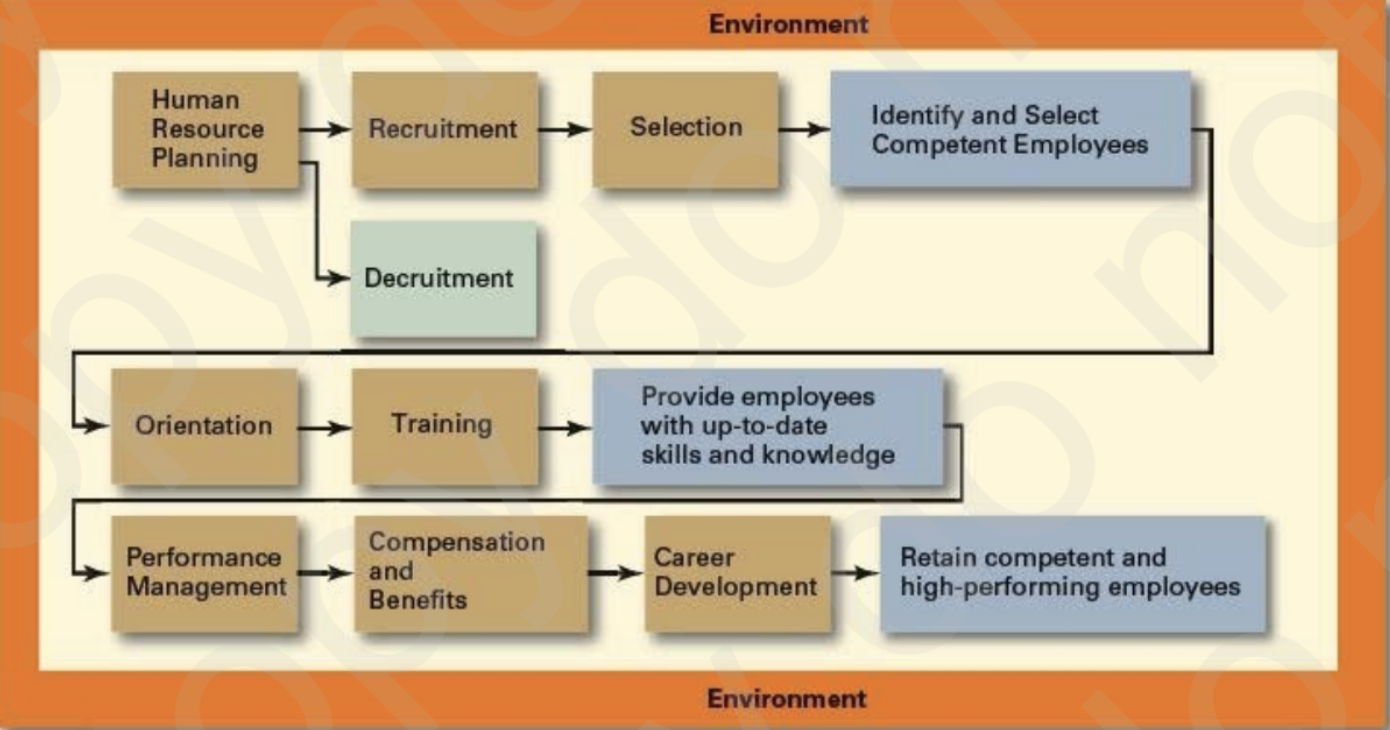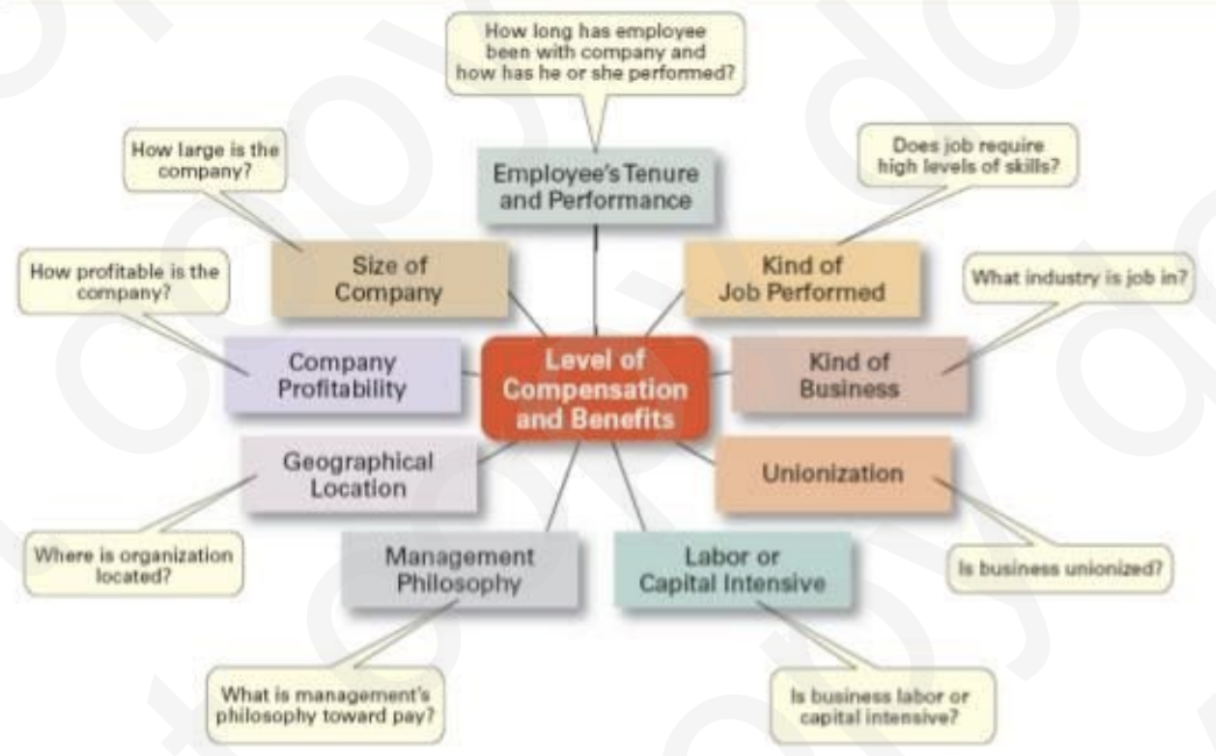MGT 101 - Managing Dynamic Human Resources
1/73
There's no tags or description
Looks like no tags are added yet.
Name | Mastery | Learn | Test | Matching | Spaced |
|---|
No study sessions yet.
74 Terms
Human Resource Management (HRM)
design and applications of formal systems in an organization to ensure the effective and efficient use of human talents to accomplish objectives (Daft)
the management of various activities activities designed to enhance the effectiveness of organization’s workforce in achieving organizational goals
formal systems for the management of people within the organization
Three Major Concerns in HRM
attracting an effective workforce through recruitment and selection (competent employees are identifies and selected)
developing an effective workforce (provide employees with up-to-date knowledge and skills)
maintaining an effective workforce (ensures that competent and high performing employees are retained)
[Three Major Concerns in HRM] attracting an effective workforce through recruitment and selection
competent employees are identifies and selected
human resource planning
recruitment
selection
[Three Major Concerns in HRM] developing an effective workforce
provide employees with up-to-date knowledge and skills
orientation
training
[Three Major Concerns in HRM] maintaining an effective workforce
ensures that competent and high performing employees are retained
performance appraisal
pay and other compensation systems
career development
workforce reductions
Factors Affecting the HRM Process
employee labor union
government laws and regulations
demographic trends
[Factors Affecting the HRM Process] Employee Labor Union
a representation of workers
protects workers interests through collective bargaining agreement (CBA)
[Factors Affecting the HRM Process] Government Laws and Regulations
Labor Code of the Philippines
[Factors Affecting the HRM Process] Demographic Trends
characteristics of the labor market
Strategic Importance of HRM
today’s best human resources departments actively pursue an ongoing, integrates plan for furthering the organization’s performance
research has found that effective human resource management has a positive impact on strategic performance, including higher employee productivity and stronger financial results (Daft)
important strategic tool
increasingly viewed as an important means to build internal capabilities towards a competitive advantage
builds human capital who have good leadership qualities and who can manage across geographical and cultural boundaries
an organization’s HRM practices has been found to have significant impact on organizational performance
HRM Process
an on-going procedure that tries to keep the organization supplied with the right positions when they are needed
Basic Activities in the HRM Process
human resource planning
recruitment
selection
socialization/orientation
training and development
performance appraisal
promotion, transfer, demotion, separation
The HRM Process

Human Resource Planning
the process of determining future human resource needs relative to an organization's strategic plan and devising steps necessary to meet those needs
process by which management ensures that an organization is supplied with the right number of capable people in the right places at the right time
accomplished through assessing current human resources and forecasting future HR needs
current assessment
[Human Resource Planning] inventory
HR Planning begins with an _____ of the current human resource. This includes pertinent information on employees, such as name, educational attainment, trainings attended, previous work experiences, special skills, and spoken languages among others.
[Human Resource Planning] employee database
_____ generated through HR Planning can help managers to efficiently identify the people they need.
[Human Resource Planning] Job Analysis
systematic process of gathering and interpreting information about the essential duties, tasks, and responsibilities required for a particular job
the information gathered through this, aids the manager in developing or revising a job description and job specification which serve as the basis for recruitment and selection, training, employee performance, and career development
[Human Resource Planning | Job Analysis] Job Description
statement of duties, working conditions, work requirements, etc.
[Human Resource Planning | Job Analysis] Job Specification
statement of skill, abilities, education, and previous work experience required for the job
[Human Resource Planning | Job Analysis] Job Design
systematic process of organizing specific jobs
[Human Resource Planning | Job Analysis] Job Enlargement
broadening the scope of a job by expanding the number of different tasks to be performed
[Human Resource Planning | Job Analysis] Job Enrichment
increasing the depth of a job by adding the responsibility for planning, organizing, controlling, and evaluating the job
[Human Resource Planning | Job Analysis] Job Rotation
the process of shifting a person from job to job
Human Resource Planning Activities
planning for future needs
planning for future balance
planning for recruiting and laying off members
planning for training and development of employees
through HR planning, the managers can assess areas in which the organization will be understaffed or overstaffed, and hence be guided in the next step of the HRM process, particularly recruitment/derecruitment
[Human Resource Planning Activities] planning for future needs
how many people with what skills are needed?
future HR needs depend on the organization’s mission, goals, and strategies
[Human Resource Planning Activities] planning for future balance
compare number of present employees who can be expected to stay with the number of needed employees
[Human Resource Planning Activities | Recruitment] capable applicants
locating, identifying, and attracting _____
[Human Resource Planning Activities] Recruitment
process of developing a large enough group of candidates to let managers select the qualified employees that they need
[Human Resource Planning Activities | Recruitment] Sources of Recruits
internal
external
[Human Resource Planning Activities | Sources of Recruits] Internal
existing employees in the organization
[Human Resource Planning Activities | Sources of Recruits] External
internet, employee referrals, company websites, college recruitment, professional recruiting organizations
[Human Resource Planning Activities | Recruitment] HRM Department
this has the responsibility for determining the applicants’ compliance with the requirements
[Human Resource Planning Activities | Recruitment] Derecruitment
reducing an organization’s workforce
[Human Resource Planning Activities | Derecruitment] Firing
permanent involuntary termination
[Human Resource Planning Activities | Derecruitment] Layoffs
temporary involuntary termination; may last for a few days or extend to years
[Human Resource Planning Activities | Derecruitment] Attrition
not filling of openings created by voluntary resignations or retirement
[Human Resource Planning Activities | Derecruitment] Reduced Workweeks
having employees work fewer hours per week, or perform jobs on a part-time basis, or share jobs
[Human Resource Planning Activities | Derecruitment] Early Retirement
provision of incentives to older or more senior employees for retiring before their compulsory retirement age
[Human Resource Planning Activities | Derecruitment] Job-Sharing Employees
employees sharing one full-time position
[Human Resource Planning Activities] Selection
screening job applicants to ensure that the most appropriate candidates are hired
[Human Resource Planning Activities | Selection] mutual process
organization makes decision in offering the job
candidate decides whether to accept the job or not
[Human Resource Planning Activities | Selection] selection devices
valid — with proven relationship between the device and relevant criteria
reliable — measures the same thing consistently over time
[Human Resource Planning Activities | Selection] decision
A _____ is correct when the applicant was predicted to be successful and proved to be successful on the job, or when the applicant was predicted to be unsuccessful and was not hired.
[Human Resource Planning Activities | Selection] steps in the selection process
job application
initial interview
testing
background investigation
in-depth selection interview
physical examination
job offer
[Human Resource Planning Activities] Orientation/Socialization
program designed to help employees fit smoothly into an organization
types of information given during orientation
general information about work routine
organization information — history, purpose, products, and services, etc.
detailed presentation of organizational policies, work rules, and employee benefits
may also include a tour of the facilities
may be formal or informal
[Human Resource Planning Activities] Training and Development
these are important because a job demands change, employee skills have to change, too
[Human Resource Planning Activities | Training and Development] training program
designed to maintain or improve current job performance
[Human Resource Planning Activities | Training and Development] development program
designed to develop skills necessary for future work activities
[Human Resource Planning Activities | Training and Development] ways to determine training needs
performance appraisal
analysis of job requirements
organizational analysis
employee survey
[Human Resource Planning Activities | Training and Development] Training Approaches vs. Development Approaches
on the job training (OJT)
internship
apprenticeship
off the job training
[Human Resource Planning Activities | Training and Development] Training Approaches vs. Development Approaches
coaching
job rotation
training positions
planned work activities
[Human Resource Planning Activities] Performance Appraisal
the process through which an organization gets information on how well an employee is doing his or her job
low performance prompts corrective actions
high performance merits rewards
informal performance appraisals—continuous process of giving feedback to employees
formal appraisal—formal rating process which is done at certain periods
[Human Resource Planning Activities | Performance Appraisal] major purpose or performance appraisal
lets the employees know formally how their current performance is being rated
identifies employees who deserve merit raises
locates employees who need additional training
identifies candidates for promotion or demotion
[Human Resource Planning Activities | Performance Appraisal] approaches to performance rating
the manager rating an employee
a group of managers rating an employee
peer evaluation
the employees rating the manager
the employee rating himself
outside sources
multisource (360° feedback) appraisal
[Human Resource Planning Activities] Compensation
reward systems attract, motivate, and retain people
[Human Resource Planning Activities | Compensation] three decisions related to designing a pay plan
pay level
pay structure
individul pay
[Human Resource Planning Activities | Compensation] pay level
low, average, or high pay
[Human Resource Planning Activities | Compensation] pay structure
how to price different jobs within the organization
[Human Resource Planning Activities | Compensation] individual pay
different pay rates for jobs of similar worth within the same family
[Human Resource Planning Activities | Compensation] factors that influence compensation and benefits

[Human Resource Planning Activities] Employee Incentives and Benefits
individual incentive plans
group incentive plans
employee benefits
[Human Resource Planning Activities | Employee Incentives and Benefits] individual incentive plans
most common type of incentive plans
consist of an objective standard against which a worker’s performance is compared
[Human Resource Planning Activities | Employee Incentives and Benefits] groups incentive plans
gainsharing
profit sharing plans
[Human Resource Planning Activities | Employee Incentives and Benefits] gainsharing
based on group performance (function of the ratio between labor costs and sales)
[Human Resource Planning Activities | Employee Incentives and Benefits] profit sharing plans
employees share based on the unit or company profitability
[Human Resource Planning Activities | Employee Incentives and Benefits] employee benefits
those required by law
those voluntarily given by an employer
cafeteria benefit program
flexible benefit program
[Human Resource Planning Activities | Employee Incentives and Benefits] cafeteria benefit program
an employee benefit program in which employees choose from a menu of options to create a benefit package tailored to their needs
[Human Resource Planning Activities | Employee Incentives and Benefits] flexible benefit program
a benefit program in which employees are given credits to spend on benefits that fit their unique needs
[Maintaining an Effective Workforce] labor relations
the system of relations between workers and management
[Maintaining an Effective Workforce] reasons for unionization
economic reasons especially for workers in low-paying jobs; they bargain to raise wages for members
job dissatisfaction encourages workers to form unions
the belief that the union can obtain desired benefits
mage of union can determine whether a satisfied worker will seek out the union
[Maintaining an Effective Workforce] collective bargaining
a periodic ritual of negotiating an agreement between over wages, hours, and working conditions
[Maintaining an Effective Workforce] Four Cs Model of Evaluating Human Resources
competence
commitment
congruence
cost effectiveness
Maintaining an Effective Workforce
labor relations
unionization
collective bargaining
labor management relations
effective compensation and benefit system
valuing and managing diversity
terminating poor performers
four Cs model of Evaluating Human Resources
Current Issues in HRM
downsizing
workplace romance
sexual harassment
drug and alcohol abuse
employees’ right to privacy
family issues
glass ceiling